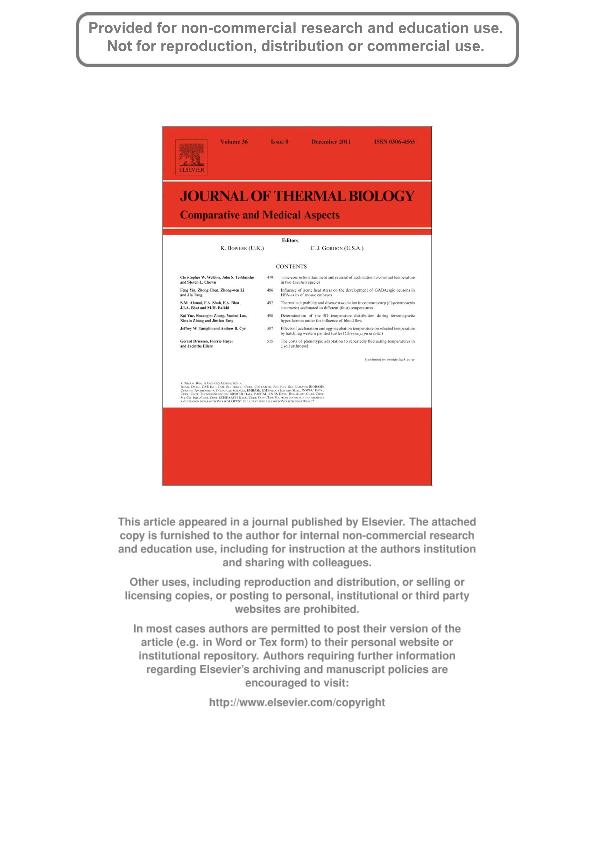Mostrar el registro sencillo del ítem
dc.contributor.author
Medina, Susana Marlin

dc.contributor.author
Scolaro, Jose Alejandro

dc.contributor.author
Méndez de la Cruz, Fausto Roberto

dc.contributor.author
Sinervo, Barry Raymond

dc.contributor.author
Ibarguengoytía, Nora

dc.date.available
2023-01-06T19:33:37Z
dc.date.issued
2011-12
dc.identifier.citation
Medina, Susana Marlin; Scolaro, Jose Alejandro; Méndez de la Cruz, Fausto Roberto; Sinervo, Barry Raymond; Ibarguengoytía, Nora; Thermal relationships between body temperature and environment conditions set upper distributional limits on oviparous species; Pergamon-Elsevier Science Ltd; Journal of Thermal Biology; 36; 8; 12-2011; 527-534
dc.identifier.issn
0306-4565
dc.identifier.uri
http://hdl.handle.net/11336/183821
dc.description.abstract
We determined the thermal biology of the oviparous Liolaemus boulengeri and the viviparous Liolaemus lineomaculatus populations localised at high and low latitude sites in Patagonia, Argentina. We present data of body temperatures in the field (Tb) and preferred temperature in the laboratory (Tpref), micro-environmental and operative temperatures and the effectiveness of thermoregulation. Liolaemus boulengeri and L. lineomaculatus choose different heat sources for active selection of suitable thermal micro-environments for thermoregulation, and the oviparous L. boulengeri is a more effective thermoregulator (E=0.55) than the viviparous L. lineomaculatus (E=0.43). Even when L. boulengeri is a better thermoregulator and both species show identical timing in the reproductive cycles, there are constraint factors that impose limitations on the southernmost distribution of the oviparous L. boulengeri.
dc.format
application/pdf
dc.language.iso
eng
dc.publisher
Pergamon-Elsevier Science Ltd

dc.rights
info:eu-repo/semantics/openAccess
dc.rights.uri
https://creativecommons.org/licenses/by-nc-sa/2.5/ar/
dc.subject
COLD CLIMATE
dc.subject
LIOLAEMUS
dc.subject
OVIPARITY
dc.subject
SQUAMATA
dc.subject
THERMOREGULATION
dc.subject
VIVIPARITY
dc.subject.classification
Biología

dc.subject.classification
Ciencias Biológicas

dc.subject.classification
CIENCIAS NATURALES Y EXACTAS

dc.title
Thermal relationships between body temperature and environment conditions set upper distributional limits on oviparous species
dc.type
info:eu-repo/semantics/article
dc.type
info:ar-repo/semantics/artículo
dc.type
info:eu-repo/semantics/publishedVersion
dc.date.updated
2021-07-30T18:04:57Z
dc.journal.volume
36
dc.journal.number
8
dc.journal.pagination
527-534
dc.journal.pais
Estados Unidos

dc.description.fil
Fil: Medina, Susana Marlin. Consejo Nacional de Investigaciones Científicas y Técnicas; Argentina. Universidad Nacional de la Patagonia "San Juan Bosco"; Argentina
dc.description.fil
Fil: Scolaro, Jose Alejandro. Consejo Nacional de Investigaciones Científicas y Técnicas. Centro Científico Tecnológico Conicet - Centro Nacional Patagónico; Argentina
dc.description.fil
Fil: Méndez de la Cruz, Fausto Roberto. Universidad Nacional Autónoma de México; México
dc.description.fil
Fil: Sinervo, Barry Raymond. University of California at Santa Cruz; Estados Unidos
dc.description.fil
Fil: Ibarguengoytía, Nora. Consejo Nacional de Investigaciones Cientificas y Tecnicas. Centro Cientifico Tecnologico Conicet - Patagonia Norte. Instituto de Investigaciones En Biodiversidad y Medioambiente. Subsede San Martín de Los Andes-inibioma | Universidad Nacional del Comahue. Centro Regional Universitario Bariloche. Instituto de Investigaciones En Biodiversidad y Medioambiente. Subsede San Martín de Los Andes-inibioma.; Argentina. Universidad Nacional del Comahue. Centro Regional Universidad Bariloche. Departamento de Zoología; Argentina
dc.journal.title
Journal of Thermal Biology

dc.relation.alternativeid
info:eu-repo/semantics/altIdentifier/url/https://www.sciencedirect.com/science/article/pii/S0306456511001288
dc.relation.alternativeid
info:eu-repo/semantics/altIdentifier/doi/https://doi.org/10.1016/j.jtherbio.2011.09.005
Archivos asociados
